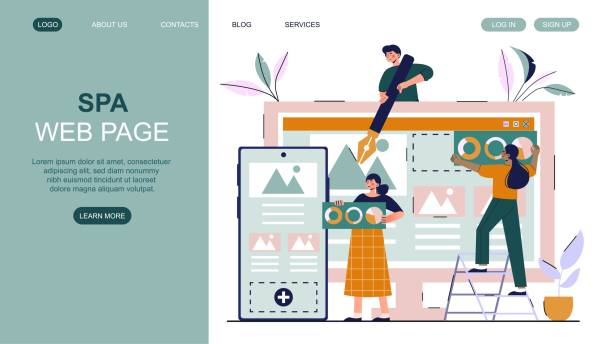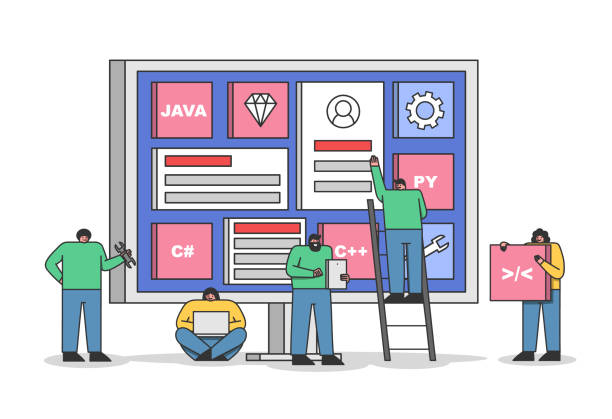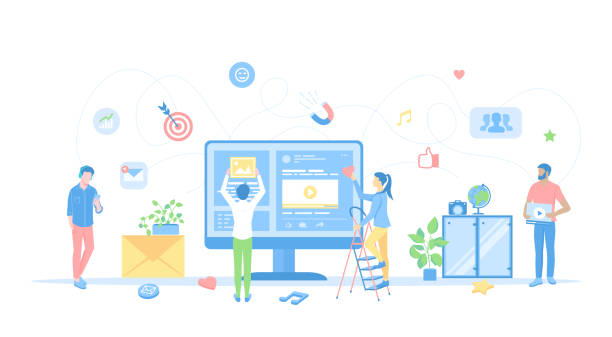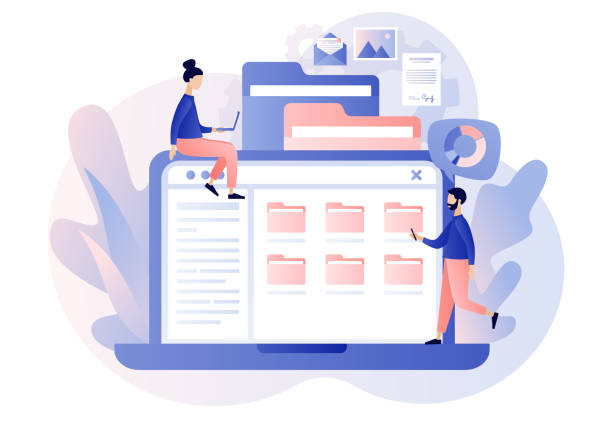The Importance of Secure Website Design in Today’s Digital World

In today’s world, where physical boundaries have faded and interactions have moved to the online space, secure website design is no longer a luxury option, but a vital necessity.
With the increasing cyber threats, every business and organization that intends to operate online must prioritize #web_security and #data_protection.
An insecure website can not only lead to the loss of sensitive user data but also severely damage customer trust and reputation, causing heavy financial losses.
The importance of website design with a security approach goes beyond protecting personal information; it also pertains to safeguarding critical infrastructure, preventing DDoS attacks, and ensuring the stability of online services.
A deep understanding of cybersecurity concepts and their implementation at every stage of web development, from initial planning to maintenance and updates, is fundamental.
Neglecting these issues can expose your business to irreparable risks, from which recovery will be time-consuming and costly.
Therefore, every development team must have sufficient knowledge in secure web architecture and continuously update their methods.
Secure website design is an ongoing process, not a one-time action.
Does your current corporate website not reflect your brand’s credibility and strength as it should? RasaWeb solves this challenge for you with professional corporate website design.
✅ Increase visitor credibility and trust
✅ Attract more targeted customers
⚡ Click for free consultation!
Common Web Security Threats and Their Identification

Understanding common threats is the first step towards secure website design.
Cyber attackers use various methods to infiltrate websites and exploit vulnerabilities.
Among the most common threats are SQL injection attacks, which allow attackers to inject malicious SQL code into the website’s database and manipulate or extract sensitive information.
XSS (Cross-Site Scripting) attack is another common threat where malicious client-side code is injected into web pages, potentially leading to the theft of cookies, user session information, or even alteration of page content.
CSRF (Cross-Site Request Forgery) attacks trick users into sending malicious requests to a trusted website without their knowledge.
In addition to these, Brute Force attacks for guessing passwords, DoS/DDoS attacks to disrupt services, and malware and viruses that can infect websites are other significant threats.
To identify these vulnerabilities, regular security scans, penetration testing, and code review are of high importance.
Accurate knowledge of these attack methods helps developers take necessary preventive measures during website development.
This proactive approach is the backbone of a secure and reliable website design.
Fundamental Principles of Web Security Design

To ensure secure website design, adhering to fundamental security principles at every stage of development is essential.
The first principle is “Security by Design”; meaning that security is embedded from the outset in the system’s design and architecture, rather than being an afterthought once development is complete.
Another principle is the “Principle of Least Privilege”; meaning that every user or system should only have access to the minimum resources and permissions necessary to perform its tasks.
Input Validation is another critical step.
All user input data must be carefully scrutinized and sanitized to prevent the injection of malicious code.
Furthermore, using Prepared Statements when working with databases is an effective way to combat SQL injection attacks.
Proper error and log management is also important; log information should contain sufficient details to detect attacks, but must not disclose sensitive information.
Continuous updating of software and libraries, using secure frameworks, and employing encryption for sensitive information are other key principles.
Paying attention to these points provides the foundation for a powerful and robust website against cyber attacks.
This comprehensive approach ultimately leads to a secure and stable website design.
| Vulnerability | Description | Countermeasure |
|---|---|---|
| SQL Injection | Injecting malicious SQL code into the database | Using Prepared Statements and ORMs |
| XSS (Cross-Site Scripting) | Injecting malicious client-side scripts | Thorough input validation and filtering, Output Encoding |
| CSRF (Cross-Site Request Forgery) | Forcing a user to send unwanted requests | Using CSRF tokens, checking referrer |
| Broken Authentication | Weakness in session management and authentication | Using secure protocols, proper session management, strong passwords |
Implementing Strong Authentication and Authorization

One of the main pillars of secure website design is the implementation of strong mechanisms for Authentication and Authorization.
Authentication means verifying the user’s identity (e.g., with a username and password), while Authorization means determining the user’s access permissions to various resources after identity verification.
For strong authentication, the use of complex and unique passwords is highly recommended.
Forcing users to use strong passwords and change them periodically, as well as preventing the reuse of old passwords, are initial measures.
Implementing two-factor authentication (2FA) or multi-factor authentication (MFA) adds a vital security layer that makes it difficult for attackers to gain access, even if a password is compromised.
In terms of authorization, appropriate access control models such as Role-Based Access Control (RBAC) should be used.
This model ensures that users only have access to parts of the site and information that are essential for their tasks.
Proper Session Management is also crucial; session IDs should be long and random, transmitted over HTTPS, and expire after a specified period or user logout.
These collective measures provide a robust security framework for protecting against unauthorized access in a web system and ensure secure website design.
Are you losing business opportunities because of an outdated website? With RasaWeb, permanently solve the problem of not attracting potential customers through your website!
✅ Attract more high-quality leads
✅ Increase brand credibility in customers’ eyes
⚡ Get free corporate website design consultation now!
Data Protection in Databases and During Transmission

Data protection, both at rest (in the database) and in transit (between user and server), is one of the most critical aspects of secure website design.
For sensitive data stored in the database, strong encryption is essential.
Passwords should never be stored in plain text; instead, they should be stored using Hashing Functions like bcrypt or Argon2 along with Salt.
This method keeps passwords irreversible, even if an attacker gains access to the database.
Personal user information such as phone numbers, email addresses, and banking details should also be stored in an encrypted format.
The use of HTTPS protocol for all web communications is non-negotiable.
HTTPS encrypts traffic between the user’s browser and the web server using SSL/TLS certificates, preventing eavesdropping, tampering, or forgery of information during transmission.
This ensures data confidentiality and integrity.
Additionally, Man-in-the-Middle (MITM) attacks should be prevented by correctly configuring the server and using HSTS (HTTP Strict Transport Security) to force browsers to always use HTTPS.
In summary, a multi-layered approach to data protection, both in storage and in transit, is the cornerstone of secure and reliable website design that can protect user information from unauthorized access.
These measures are essential for any secure website.
The Role of Protocols and Server Configuration in Web Security

Correct server configuration and the use of secure protocols are an inseparable part of secure website design.
The web server is the foundation for executing code and storing site information, so its security is of paramount importance.
The first step is using updated and patched operating systems.
All server software, including web servers (such as Apache or Nginx), databases (such as MySQL or PostgreSQL), and runtime environments (such as PHP, Node.js, Python), must be updated to the latest stable and secure versions.
Incorrect configuration can create major vulnerabilities.
It is essential to ensure that unnecessary functionalities are disabled and default files and directories that might disclose server information are removed.
Also, the SSH protocol for remote server access must be protected with strong passwords or, even better, with SSH keys.
Firewalls play a crucial role in controlling incoming and outgoing traffic to the server and should be configured to only open essential ports.
Intrusion Detection Systems (IDS) and Intrusion Prevention Systems (IPS) can identify and block suspicious traffic.
Furthermore, for a secure site, using a CDN (Content Delivery Network) not only increases loading speed but can also act as an initial security layer against DDoS attacks.
These measures together provide a stable and secure environment for the website and are essential for any secure website design.
Vulnerability Management and Continuous Updates

One of the most important aspects of maintaining secure website design is active vulnerability management and continuous updates.
Security is not a static process; rather, it requires continuous care and attention.
Software, frameworks, and libraries used in website development are continuously reviewed by security researchers and hackers, and new vulnerabilities may be discovered in them.
Therefore, timely installation of security patches provided by developers is of high importance.
Scheduling regular security scans (Vulnerability Scans) and Penetration Testing by cybersecurity specialists helps identify weaknesses before they are discovered by attackers.
These tests can include reviewing server configuration, programming code, and even user behavior.
Additionally, a Vulnerability Management System should be implemented to allow for tracking, evaluating, and remediating vulnerabilities.
Continuous monitoring of server logs and security software to detect suspicious activities is also crucial.
This combined proactive and reactive approach ensures that the website remains resilient against new threats and maintains its nature as a secure website design.
Remember, every website requires a continuous security hardening process.
| Row | Security Action | Recommended Frequency |
|---|---|---|
| 1 | Install OS and software security patches | Weekly/Monthly |
| 2 | Review server and application security logs | Daily/Weekly |
| 3 | Perform Vulnerability Scans | Monthly/Quarterly |
| 4 | Conduct Penetration Testing | Annually/After major changes |
| 5 | Review user and system access permissions | Quarterly/Upon role change |
| 6 | Review and update SSL/TLS certificates | Based on expiration date |
Client-Side Security and Prevention of Client-Side Attacks

Client-Side Security is a crucial part of the secure website design strategy that is often overlooked.
Client-side attacks, such as XSS (Cross-Site Scripting) and CSRF (Cross-Site Request Forgery), directly target website users and can lead to information theft, session hijacking, or even the execution of malicious code in the user’s browser.
To counter XSS, the most important step is thorough validation and filtering of all user inputs, even those obtained via APIs or other sources.
Also, when displaying user-generated content, it is crucial to ensure proper Encoding (HTML Entity Encoding) so that codes are displayed as text rather than executed.
To prevent CSRF, the use of anti-CSRF tokens (CSRF Tokens) in all submitted forms is vital.
These tokens are random strings, unique to each form request, and validated by the server.
If the token does not match, the request is rejected.
Additionally, proper configuration of HTTP security headers like Content Security Policy (CSP) can instruct the browser to load resources (such as scripts and styles) only from trusted sources, preventing the execution of injected scripts.
Securing cookies with HttpOnly and Secure flags also helps prevent scripts from accessing cookies and ensures their transmission only over HTTPS.
These measures, combined with educating users to recognize phishing attacks, provide a strong defensive layer for secure website design.
Dissatisfied with your e-commerce site’s low sales?
RasaWeb is your solution for a professional and high-selling e-commerce site.
✅ Significant increase in sales and revenue
✅ Easy and enjoyable shopping experience for customers
⚡ Get a free e-commerce site design consultation from RasaWeb now!
Incident Response and Data Recovery

Even with the best approaches to secure website design, the probability of security incidents never reaches zero.
Therefore, having a comprehensive Incident Response Plan and a Disaster Recovery Plan is vital for any organization.
This plan should include steps for incident identification, containment, root cause analysis and eradication, and finally, system recovery.
Early identification is possible through monitoring systems and comprehensive logs.
After identification, the goal is to contain the incident to prevent its spread, which may involve disconnecting infected sections or isolating servers.
Forensic analysis to understand how an attack occurred and to trace its root cause helps prevent similar attacks in the future.
Eradication means the complete removal of malicious components and repair of damages.
Finally, recovery means restoring systems and data to normal operational status.
This stage requires regular and reliable data backups, which should be stored encrypted and in separate locations.
Periodically testing backup and recovery plans ensures that they function correctly during a crisis.
Training teams to respond quickly and effectively to incidents is also of high importance.
Having a strong incident response plan not only increases website resilience but also significantly helps maintain user trust and reduce damages from attacks.
This component of secure website design is vital and indispensable.
Future Outlook of Web Security and Emerging Trends

The future of secure website design is constantly evolving, and with the emergence of new technologies and threats, security approaches must also adapt.
One of the significant trends is the increasing use of Artificial Intelligence (AI) and Machine Learning (ML) in security systems.
These technologies can detect suspicious traffic patterns with higher accuracy, predict attacks, and respond to them automatically.
On the other hand, web development is moving towards distributed architectures such as microservices and serverless services, each having its own security challenges and requiring new approaches to infrastructure security.
Blockchain, with its promise of increased transparency and decentralization, also has the potential to impact identity and data security.
API security has also become a critical area with the widespread use of APIs in communications between various services and applications, requiring strong authentication, precise authorization, and continuous monitoring.
With the advent of quantum computing, current cryptographic methods may become vulnerable in the future, making the development of Post-Quantum Cryptography essential.
Finally, security awareness and continuous training for developers and users will always remain a key factor in secure website design.
Given the rapid pace of change in the cyber domain, organizations and developers must always be learning and adapting to these emerging trends.
Frequently Asked Questions
| Row | Question | Answer |
|---|---|---|
| 1 | What is secure website design? | The process of designing and developing websites that are resistant to cyber attacks and protect user data and privacy. |
| 2 | Why is website security important? | To prevent data breaches, financial losses, damage to company reputation, and maintain user trust. |
| 3 | What are some common website security threats? | SQL Injection, XSS (Cross-Site Scripting), CSRF (Cross-Site Request Forgery), weak authentication, and unpatched software. |
| 4 | What are SSL/TLS and what is their role? | Protocols for encrypting data between the user’s browser and the website server, ensuring secure and private communication. |
| 5 | How can SQL Injection attacks be prevented? | By using Prepared Statements/Parameterized Queries, input validation, and ORMs (Object-Relational Mappers). |
| 6 | What is the role of a Web Application Firewall (WAF) in security? | A WAF monitors and filters HTTP traffic between a web application and the Internet to prevent malicious attacks. |
| 7 | Why is regular updating of software and libraries essential? | Updates include patches for known security vulnerabilities that attackers can exploit. |
| 8 | How can XSS attacks be prevented? | By sanitizing and escaping all user inputs before displaying them on the web page and using Content Security Policy (CSP). |
| 9 | What does the Principle of Least Privilege mean? | It means that users and systems are granted only the minimum necessary permissions to perform their tasks, preventing unnecessary access to resources. |
| 10 | What is the importance of proper user session management? | To prevent user session hijacking and unauthorized access to user accounts through secure and expiring session tokens. |
And other services by Rasa Web Advertising Agency in the field of advertising
- Smart Conversion Rate Optimization: A fast and efficient solution for digital branding with a focus on SEO-driven content strategy.
- Smart Social Media: A creative platform for improving customer behavior analysis with custom programming.
- Smart Data Analysis: A dedicated service for growth in click-through rate based on marketing automation.
- Smart Conversion Rate Optimization: A combination of creativity and technology to increase sales by using real data.
- Smart Marketing Automation: A novel service for enhancing customer behavior analysis through attractive UI design.
And over hundreds of other services in the field of internet advertising, advertising consultation, and organizational solutions
Internet Advertising | Advertising Strategy | Advertorials
Sources
Principles of Secure Website Design
Website Security: Comprehensive Guide for Webmasters
Most Important Security Tips for Website Design
How to Design a Secure Website?
? RasaWeb Afarin leads your business to new horizons of success by offering comprehensive digital marketing services, from multilingual website design and SEO to content marketing and social media. Contact us for consultation and to enhance your online presence.
📍 Tehran, Mirdamad Street, next to Bank Markazi, Southern Kazeroon Alley, Ramin Alley, No. 6



